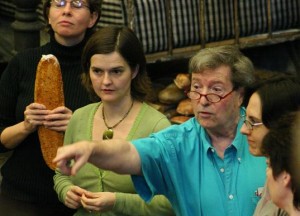John Copley’s production of La Bohème for the Royal Opera is now thirty-eight years old and being dusted off again for performances at Christmas and beyond. Rolando Villazón is Rodolfo, alongside a range of less famous singers, in a show that was made before many of them were even born.
 It’s an attractive and effective production in which most of the choristers – regulars and extras – have appeared tens or even hundreds of times. Some full-timers have literally carried the same tray of plastic cakes or fish for twenty years, and followed pretty much the same track around the stage for all that time.
It’s an attractive and effective production in which most of the choristers – regulars and extras – have appeared tens or even hundreds of times. Some full-timers have literally carried the same tray of plastic cakes or fish for twenty years, and followed pretty much the same track around the stage for all that time.
There is also a host of other choristers, some of whom are regular extras in this production, some of whom are new to the show, or who are replacing a different singer from last time. This is where the fun starts. In theory the stage manager’s ‘bible’ for the show (aka The Book) contains all the production moves. In reality, after a show that has run for this long, many things are not written down but just held in the collective memory.
So far so good, but this week I am in a new ‘role’ as one half of a couple eating dinner in Café Momus. Alas my beau is doing jury service and may not be back until the General rehearsal or even perhaps the first night. His (real-life) wife has provided some information about when he thinks we make a crucial move to make way for the incoming soloists and, other than that, I’m on my own. Happily plenty of people help me discover where I am NOT supposed to go after leaving Momus: I am moved on by the baker, then a bourgeois lady and finally a tramp, before finding safety with the man roasting chestnuts. Cue a long innuendo-laden conversation about hot nuts, which we occasionally break off for a quick burst of “la Ritirata” before getting out of the way of the trumpets (who aren’t there today but who will be coming along this ledge on the night and will flatten us).
In the old days, the hefty set was moved around by ‘push-and-pull’ – the brute strength of the stage-crew, who could swap Rodolfo’s garret for Cafe Momus in a mesmerising high-speed ballet of spinning stage-trucks and wobbling flats. It was sometimes done as an ‘open’ change (ie with the curtain open) to allow the audience to admire it too. Nowadays, we are pre-set on a big stage truck which creeps into position at agonisingly slow speed.
A number of the actors in the show were in this Bohème when it was first made and, having reprised their roles in every subsequent revival, must surely qualify for a ROH long-service medal. The philosophical paradox about Theseus’ Ship (if you replace all the bits of the ship over time is it still the same ship?) could hold true of this show. It has been going so long that everything, with the exception of some of the cast, has at some time been renewed. Clothes and set have been worn out and replaced, although the costume supervisor in my fitting wondered where they would nowadays find paisley-print corduroy in such a fetching shade, should it every become necessary to replace my shawl.
At what point, I wonder, will the last original component part be gone? Will that be the moment to retire the show and make a radical new one? Or is Copley’s Bohème, with its lavish period detail and heavy scent of nostalgia for the days when even the smallest roles were filled by a superstar, destined to outlive all the young pretenders?
Photo: Neil Gillespie